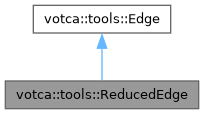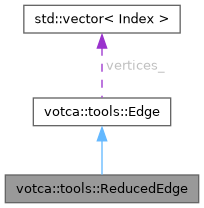Connects two vertices, also stores the vertices between the endpoints. More...
#include <reducededge.h>


Public Member Functions | |
| ReducedEdge ()=default | |
| ReducedEdge (std::vector< Index > vertices) | |
| ReducedEdge (Index vertex1, Index vertex2) | |
| std::vector< Index > | getChain () const |
| Returns a vector of vertices that constitute the edge. | |
| bool | vertexExistInChain (const int &vertex) const |
| Provided a vertex this method will determine if it exists within the reduced edge. | |
| std::vector< Edge > | expand () const |
| Method expands the edge into its parts. | |
| bool | operator== (const ReducedEdge &edge) const |
| Checks if Edges are equivalent. | |
| bool | operator!= (const ReducedEdge &edge) const |
| Checks if Edges are not equivalent. | |
| bool | operator< (const ReducedEdge &edge) const |
| bool | operator> (const ReducedEdge &edge) const |
| bool | operator<= (const ReducedEdge &edge) const |
| bool | operator>= (const ReducedEdge &edge) const |
| virtual bool | operator!= (const Edge &ed) const |
| Checks if Edges are not equivalent. | |
| virtual bool | operator== (const Edge &ed) const |
| Checks if Edges are equivalent. | |
| virtual bool | operator< (const Edge &ed) const |
| virtual bool | operator> (const Edge &ed) const |
| virtual bool | operator<= (const Edge &ed) const |
| virtual bool | operator>= (const Edge &ed) const |
| Public Member Functions inherited from votca::tools::Edge | |
| Edge ()=default | |
| virtual | ~Edge ()=default |
| Edge (Index ID1, Index ID2) | |
| Index | getOtherEndPoint (Index ver) const |
| Given one of the integers in the edge the other will be output. | |
| Index | getEndPoint1 () const |
| grab the smaller integer | |
| Index | getEndPoint2 () const |
| grab the larger integer | |
| bool | loop () const |
| Checks to see if an edge loops back on itself. | |
| bool | contains (Index ID) const |
| Determine if the edge contains the Index ID. | |
Friends | |
| std::ostream & | operator<< (std::ostream &os, const ReducedEdge &edge) |
| Print the contents of the edge. | |
Additional Inherited Members | |
| Protected Attributes inherited from votca::tools::Edge | |
| std::vector< Index > | vertices_ |
Detailed Description
Connects two vertices, also stores the vertices between the endpoints.
The edge class stores the ids of two seperate vertices indictating that they are connected (id1,id2). The vertex with the lower id is always at EndPoint1 and the vertex with the large id is always placed at end point 2.
Unlike, the more basic edge class the reduced edge class allows the user to store a chain of vertices that exist between the two endpoints. For instance an edge of the form:
1 - 2 - 3 - 4
Can be stored, in this case EndPoint1 will be vertex 1 and EndPoint2 will be vertex 4. The class name is called a reduced edge because the edge is treated as if it were an edge of only two vertices described as
1 - 4
Definition at line 49 of file reducededge.h.
Constructor & Destructor Documentation
◆ ReducedEdge() [1/3]
|
default |
◆ ReducedEdge() [2/3]
| votca::tools::ReducedEdge::ReducedEdge | ( | std::vector< Index > | vertices | ) |
Creates an edge the smallest integer value will be placed in the id1 spot and the larger in the id2 spot
Definition at line 99 of file reducededge.cc.
◆ ReducedEdge() [3/3]
Definition at line 57 of file reducededge.h.
Member Function Documentation
◆ expand()
| vector< Edge > votca::tools::ReducedEdge::expand | ( | ) | const |
Method expands the edge into its parts.
This method will take an expanded edge e.g.
1 - 2 - 3 - 4 - 5
And break it up into its more primitive edges:
1 - 2, 2 - 3, 3 - 4, 4 - 5
These edges will then be placed in a vector and returned.
- Returns
- vector of edges
Definition at line 116 of file reducededge.cc.
◆ getChain()
|
inline |
Returns a vector of vertices that constitute the edge.
Definition at line 61 of file reducededge.h.
◆ operator!=() [1/2]
|
virtual |
Checks if Edges are not equivalent.
Reimplemented from votca::tools::Edge.
◆ operator!=() [2/2]
| bool votca::tools::ReducedEdge::operator!= | ( | const ReducedEdge & | edge | ) | const |
Checks if Edges are not equivalent.
Definition at line 143 of file reducededge.cc.
◆ operator<() [1/2]
|
virtual |
If the vertices are smaller in value Edge ed1(2,3); Edge ed2(1,5); Edge ed3(4,1); priority is given to the smallest vertex assert(ed2<ed1); // will return true assert(ed3<ed1); // will return true assert(ed3<ed1); // will return true
Reimplemented from votca::tools::Edge.
◆ operator<() [2/2]
| bool votca::tools::ReducedEdge::operator< | ( | const ReducedEdge & | edge | ) | const |
The Reduced Edge follows the same rules as the more basic edge when the EndPoints are differet between the two edges
If the vertices are smaller in value Edge ed1(2,3); Edge ed2(1,5); Edge ed3(4,1); priority is given to the smallest vertex assert(ed2<ed1); // will return true assert(ed3<ed1); // will return true assert(ed3<ed1); // will return true
In the case that the two edges have the same endpoints:
Edge ed4(vector<Index>{ 1, 5, 4}); Edge ed5(vector<Index>{ 1, 2, 3, 4});
The shorter of the two edges is considered smaller assert(ed4<ed5); // will return true
In the case that both edges have the same number of vertices the edge with the first vertex in the chain that is lower in value will be considered smaller.
Edge ed6(vector<Index>{ 1, 2, 5, 4}); assert(ed5<ed6); // will return true;
Definition at line 147 of file reducededge.cc.
◆ operator<=() [1/2]
|
virtual |
Reimplemented from votca::tools::Edge.
◆ operator<=() [2/2]
| bool votca::tools::ReducedEdge::operator<= | ( | const ReducedEdge & | edge | ) | const |
Definition at line 171 of file reducededge.cc.
◆ operator==() [1/2]
|
virtual |
Checks if Edges are equivalent.
Reimplemented from votca::tools::Edge.
◆ operator==() [2/2]
| bool votca::tools::ReducedEdge::operator== | ( | const ReducedEdge & | edge | ) | const |
Checks if Edges are equivalent.
Definition at line 131 of file reducededge.cc.
◆ operator>() [1/2]
|
virtual |
Reimplemented from votca::tools::Edge.
◆ operator>() [2/2]
| bool votca::tools::ReducedEdge::operator> | ( | const ReducedEdge & | edge | ) | const |
Definition at line 175 of file reducededge.cc.
◆ operator>=() [1/2]
|
virtual |
Reimplemented from votca::tools::Edge.
◆ operator>=() [2/2]
| bool votca::tools::ReducedEdge::operator>= | ( | const ReducedEdge & | edge | ) | const |
Definition at line 179 of file reducededge.cc.
◆ vertexExistInChain()
| bool votca::tools::ReducedEdge::vertexExistInChain | ( | const int & | vertex | ) | const |
Provided a vertex this method will determine if it exists within the reduced edge.
Given a reduced edge
1 - 2 - 3 - 4
Calling the method with vertex 3 will return true as the vertex exists within the chain stored by the reduced edge.
- Parameters
-
[in] vertex Index potential vertex stored in the reduced edge
- Returns
- bool true if it is in the chain false otherwise
Definition at line 125 of file reducededge.cc.
Friends And Related Symbol Documentation
◆ operator<<
|
friend |
Print the contents of the edge.
Definition at line 183 of file reducededge.cc.
The documentation for this class was generated from the following files:
- tools/include/votca/tools/reducededge.h
- tools/src/libtools/reducededge.cc